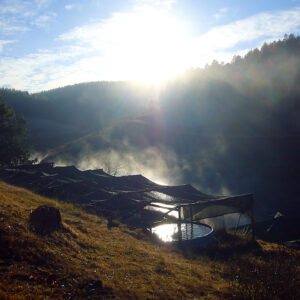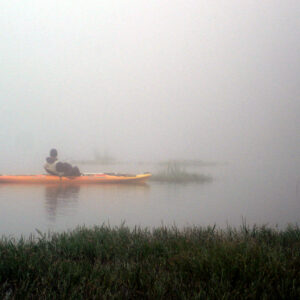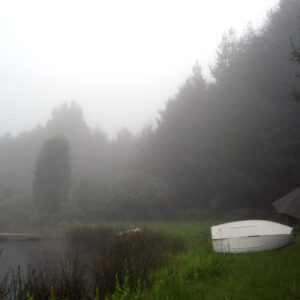Taken from: Magoebaskloof - Land of the Silver Mist ~ By Giordano Zamparini
“The Land of the Silver Mist” – was how Lord John Buchan (1875 -1940), future Governor-General of Canada and acclaimed author of the Thirty Nine Steps, described the Magoebaskloof area. A prolific author, he is credited as being the first writer of suspense thrillers. After the Boer War, he was seconded to Pietersburg now( Polokwane) to take charge of reconstruction. It was during this time that he fished the streams of Magoebaskloof and he often expressed a desire to retire in the area.
Magoebaskloof is home to the Haenertsburg Trout Association (HTA), thought to be the oldest fly fishing club in the country.
Established in 1906 as an offshoot of the Transvaal Trout Acclimatizing Society, the HTA changed to its present name on the 9th of December 1911.
The Broederstroom, while still within the club boundaries, becomes the well-known Letaba River of the Kruger National Park. Rumour has it that kudu, crocodiles and zebras were once seen and photographed on its banks, this, in contrast to the Helpmekaar that can only boast of once hosting a lone hippo in its waters and not for long either, the cold water probably making it retreat to the warmer climate of the nearby Lowveld. After forming the picturesque Lakeside and Stanford Dams, the Helpmakaar cascades into the Ebenezer dam forming a large pool, teeming with trout during winter months, the jewel of the club’s still waters, in my opinion, is the Dap Naude Dam, renowned for its wild rainbow trout that breed in the upper reaches of the Broederstroom, its main feeder. This is one of the few dams in the country where stocking is not necessary. The trout in this impoundment are a Scandinavian strain. Subtly patterned and displaying the most delicate colours, these wild fish seldom exceed 35 centimetres. Doddington’s Weir, however, a few kilometres downstream, often produces fish in excess of 45 centimetres.
Today, the rivers are a pale shadow of the waters originally stocked in 1905/6 by local farmers and businessmen but they still fish well, the brown trout in the section below Dap Naude Dam, providing an exceptional challenge. Strangely, above the dam and only a kilometre away, only rainbows are found.
There is some confusion as to the origin of the originally stocked fish, but the various records indicate that between 1905 and 1907 two hundred and fifty fish, from a short-lived hatchery in Potchefstroom, was released by Mr C Harvey on the aptly named “Clear Waters” farm and on Sir Lionel Phillips’ estate – Broederstroom Stud Farm. Another five hundred fingerlings were placed in the stream near Haenertsburg Village just above its confluence with Ebenezer Dam.
The fertilised ova were originally obtained from the famed Jonkershoek hatchery in Stellenbosch and the fingerlings were then transported first to Pietersburg by train in large milk pails and then to Haenertsburg by the famous Zeederberg Coach Company, an uncomfortable full day’s ride. The Zeedeberg Coach Company was the first and probably the only one to use zebras, unsuccessfully as it proved, as draught animals. Ingeniously the fish were kept alive by oxygenating the water with a bicycle pump, an idea that Arthur Eastwood, one of the founder members came up with. This simple innovation also made it possible for the HTA members to stock the most remote streams with fingerlings by carrying the fish on their backs through the forests and up the steep slopes of the Drakensburg, in specially modified milk cans. These streams, such as the Thabina and Mathlapetsi, are still populated with the descendants of the original stockings and are quite protected because access is difficult.
In his book, Fly Fishing in Southern Africa, the late Robert Kirby, indicated that in the early 1900’s Sir Percy Fitzpatrick, of Jock of the Bushveld fame, stocked the source of the Broederstroom River. However, Kirby was mistaken in stating that the farm, Broederstroom, belonged to Fitzpatrick. It was in fact his good friend and business partner, Sir Lionel Phillips’ farm.
Sir Lionel, a mining magnate, was chairman of the Chamber of Mines and one of the famed members of the Reform Committee. The Reform Committee originally sided with Cecil John Rhodes and, amongst its other shenanigans, was also blamed for collusion with the planners of and participants in the Jameson raid. He was sentenced to death for his actions by President Paul Kruger but was pardoned and became the first president of the HTA.
In those days, trout weighing more than seven pounds were regularly caught in the Magoebaskloof streams, but commercial timber plantations and other negative farming practices have impacted the quality of the fishing. As these streams are situated within or close to plantations, the water is slightly acidic and it flows over ferrous soil which results in a relatively small head of resident fish. Not withstanding this, fishing the Broederstroom as it winds its way amongst the gnarled European Oak trees and through the cathedral-like atmosphere created by the 60-year-old Pin Oaks is a memorable experience. Don’t expect to catch a large number of fish – two per day is a good return and then only if you are a skilled fly fisher.
Another “character” and a long-serving president of the association was Dr J.L. ‘Jock’ Stewart. The good doctor was fanatical about his fish and took poaching and any transgression of the rules rather personally. He was known to sit in hiding on the hill overlooking Stanford and Lakeside Dams and take potshots at any poacher with his .22 rifle: thankfully he aimed at the water next to the transgressors. Less lucky were the members who dared using a small spinner on their fly rods – in their case he aimed at their rods.
A little known fact is that thanks to the zeal and perseverance of Dr Stewart, the HTA has been the legal guardian of the conservation area around the Lakeside Dam since the 1950s, a fact confirmed and recognised by Nature Conservation during the recent debates on NEMBA and trout zoning, and instrumental in their acceptance of the HTA as a long term custodian of the Magoebaskloof/Haenertsburg trout waters.






